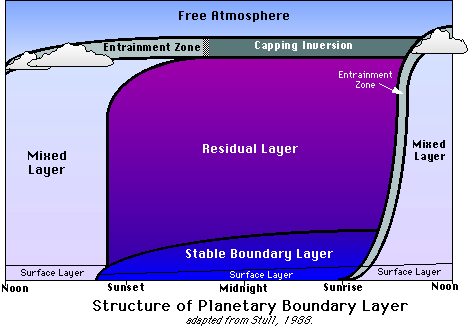Part 2:
Structure of the Planetary Boundary
Layer
The PBL can be subdivided into four separate component layers:
the surface layer, the mixed layer, the stable layer, and the
residual layer. We will discuss each of these in turn.

(Click on image to view in separate window)
The surface layer is the sub-layer closest to the earth
where turbulent stresses are relatively constant (varying by less
than 10 percent of their magnitudes). Therefore, the height of
the surface layer is 10 percent of the height of the PBL. Between
the surface layer and the earth's surface is a very thin layer
called the microlayer. In this layer (which is only a few
centimeters thick), molecular viscosity dominates over turbulent
motion. Above the surface layer is either the mixed layer or the
stable layer, depending on the temperature structure of the PBL.
During the daytime, surface heating leads to convective motion in
the PBL. Heat transfer from the surface forms rising warm air.
Radiative cooling from clouds forms sinking cooler air.
Convective motion also leads to significant turbulence which
mixes the air within this layer.
Because of the convective motion and significant mixing of air,
this sub-layer is called the convective layer or mixed
layer. Above the mixed layer is a stable layer which prevents
the continued upward motion of thermals. This stable layer also
restricts turbulence, preventing frictional influences from
reaching above the PBL. This stable layer is called the
entrainment zone, because it is here where air from above
the PBL entrains into the
mixed layer. During the day, the mixed layer reaches heights over
1 km and make up the entire layer of the PBL above the surface
layer. However, the mixed layer vanishes with the sun as the
thermally driven convection ceases.
After sunset, convective motion dramatically decreases. However,
the earth's surface still affects the air, and a stable
boundary layer forms (also called the nocturnal boundary
layer) . This boundary layer is charaterized by light winds and
weaker, more sporadic turbulence than in the mixed layer. The
height of the PBL, therefore, decreases significantly during the
night. Though the height of the nocturnal layer varies, it is
usually less than half that of the mixed layer. Unlike the mixed
layer, the stable boundary layer does not have a well-defined
top. Instead, it slowly merges with the residual layer.
As turbulence and the mixed layer decay with sunset, the air
maintains many of the state variables that
the well-mixed air had. This layer is called the residual
layer (because its properties are residuals of the mixed
layer) and forms above the stable boundary layer. While the
nocturnal boundary layer has a very stable profile, the residual
layer tends to have more of a neutral profile. The residual layer
does not have contact with the earth's surface, and so is not
influenced by turbulent stresses like the stable boundary layer
below it. The residual layer is bounded above by a capping
inversion, which approximates the height of the daytime height of
the mixed layer. This inversion simply prevents entrainment from
aloft.
Because the residual layer is not influenced directly by the
earth's surface (i.e. no turbulent stresses) it is not considered
a boundary layer. However, we include it in our discussion for
descriptive purposes. Only the mixed layer and stable layer are
true boundary layers.
Because turbulent fluxes vary based on surface heating and other
factors, the height of the PBL also varies. At night, the height
of the PBL decreases dramatically as the stable layer forms. The
height of the PBL is called the mixing height, because it
is the height up to which the air is well-mixed. The mixing
height is very important to air quality experts when determining
air pollution dispersion. We will cover this more in the Focus on Air Quality section. Meanwhile,
we'll look at some of the factors which influence the PBL.




Developed by
 The
Shodor
Education Foundation, Inc.
The
Shodor
Education Foundation, Inc.
Copyright © 1996


 The
Shodor
Education Foundation, Inc.
The
Shodor
Education Foundation, Inc.